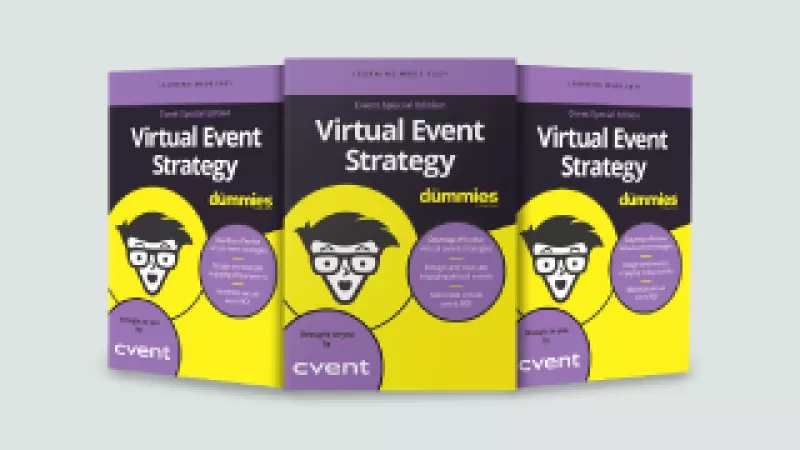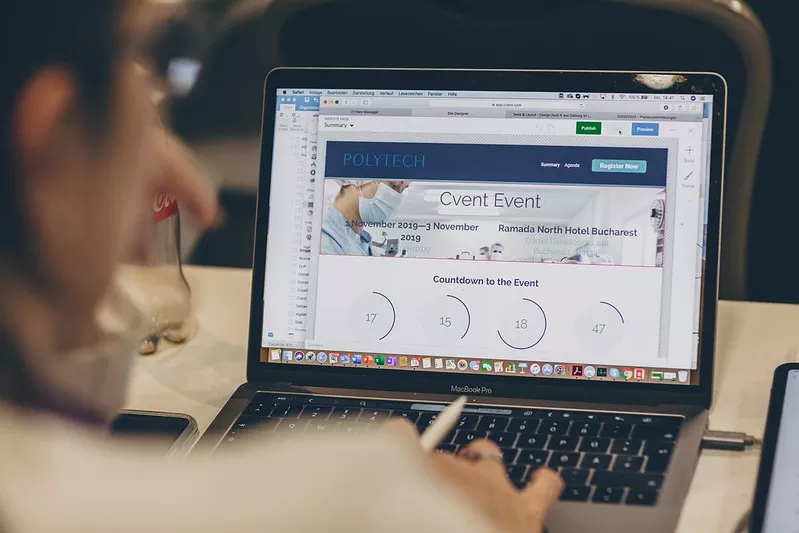Virtual events are digital gatherings where attendees experience an event's content online rather than in-person. Through virtual events, planners are able to reach wider audiences for a lower price.
The value of face-to-face interaction will never go away, but there are times when going virtual is a necessary part of your event program. But how do you turn a multi-day conference, filled with networking opportunities, educational sessions, and the attendee insights they generate into virtual events?
And once you do, how do you ensure attendees are engaged throughout the event?
Hosting a virtual event requires the same care and attention as an in-person event. In both cases, you need to craft an event strategy to effectively promote the event, engage your attendees, create memorable moments for attendees, and prove event success.
The only thing that’s missing is the venue and the attendees on-site. But, by thinking of virtual events not as small one-off presentations or as a webinar, but as value-added, engagement-driven experiences, you can create an impactful event that extends well beyond a computer screen.
What is a Virtual Event?
Odds are you’ve attended a webinar online, watched an on-demand workout class, or joined a meeting using a video conferencing tool. You might even have attended a conference from the comfort of your desk. These are all examples of virtual events. A virtual event is one where individuals experience the event and its content online rather than gathering in-person.
7 Types of Virtual Events
When it comes to your total event program, virtual events can be added to the mix of events you host, events you attend, and your internal events. Virtual events are not a replacement for other types of events, but a new type to add and to enhance your entire program. Below are the four main types of virtual events
1. Webinars
Webinars typically last somewhere from 30 to up to 80 minutes. The advantage of hosting webinars is that they allow attendees from around the world to join in and listen as one or more speakers present the content. Companies can charge attendees to join webinars using online payment services or can be offered for free. Webinars typically use video conferencing tools that allow Q&A, the ability to present live or a pre-recorded video, and be offered as on-demand after the fact. Due to their one-off educational nature, webinars have thrived with 100% virtual attendance. These can also include internal and external training.
2. Virtual Conferences
Much like in-person conferences, virtual conferences are built around a live, complex agenda that includes keynotes, sessions, breakouts, and more. Virtual conferences include multi-session content and can involve community engagement tools. While not as effective in terms of lead capture and networking as an in-person event, virtual conference management tools allow attendees to view keynotes in real-time, build their own agenda from relevant, on-demand content, and interact with other attendees.
3. Internal Hybrid Events
These are virtual town halls, sales kickoffs, companywide events, trainings, department meetings, and more. For organizations that span countries, even continents, internal hybrid events are used to share a message to the entire company when employees are not all gathered in the same place. While it would be great to fly every employee to your organization’s headquarters, it would be incredibly costly, and the scheduling required would be time-consuming. The next best option is to host events that are part in-person, part virtual. Virtual team-building activities can work well at internal hybrid events.
4. External Hybrid Events
These events are held for those outside of your organization. They can be user conferences or industry conferences. These events require higher levels of video production so that virtual attendees are provided with a quality similar to that of in-person attendees. These events allow attendees who are unable to travel to the event to participate and learn. It is challenging to provide the same value at external hybrid events, as in-person attendees are able to network more freely and engage easily with content than those attending virtually.
5. Virtual Exhibitions
Putting aside the fact that many may have felt forced into trying this new way of approaching events, there’s actually a whole host of fantastic benefits for everyone involved, and plenty of ways that virtual exhibitions can provide an enhanced experience for both your audience and for you as marketers or event organizers. As is the case with other virtual events, your ability to attract a wider audience via digital has become very popular worldwide.
6. Virtual Seminars
Virtual seminars have typically been used to showcase product offerings in intimate settings like restaurants and in person. The digital boom has (with the right technology powering them) brought these types of marketing/sales events online, bringing with them a similar level of engagement if planned properly.
7. Virtual Trade Shows
Trade shows were obviously created as in-person experiences, and in that format work best. But they still work virtually.
According to Forbes, trade shows will come back —we've already seen it. But they do need to be approached differently, and having the right strategy in place will help you thrive in the virtual world.
Why Host a Virtual Event?
Virtual events are held for the same reasons as in-person events: to deliver your company’s message to drive leads and revenue, drive adoption, and build loyalty and lifetime value. Meeting and event planners have been making the choice between in-person, virtual, and hybrid events for years, and each type of event comes with its own set of pros and cons. For instance, a webinar benefits from being virtual as it is purpose-built to cast a wide net to deliver thought-leadership, training, or some other content, whereas a user conference or regional training program is purpose-built to create 1:1 in-person interactions that face-to-face delivery enhances. This year, Microsoft pivoted to virtual with their Build developer conference. When deciding whether or not to make your event virtual, consider what you hope to gain from the event and how well those goals can be reached virtually versus in-person.
Here are a few reasons to host a virtual event:
- Accessibility: While the event is still being held in person, virtual options allow you to accommodate attendees who cannot attend in person.
- Budget: Your organization needs to cut costs, and making smaller events and webinars virtual can help move money to the biggest event of the year that brings in the largest number of leads. It also helps to have a virtual or hybrid option when attendee travel budgets are a concern.
- There’s no other option: Whether due to the extreme weather, travel bans, or an act of God, you’re forced to make your in-person event virtual or cancel it altogether.
In-person or Virtual - The Fundamentals Matter
Event planning comes down to the fundamentals. All events, in-person or virtual, are likely already part of your integrated marketing mix. Are you thinking about your in-person and virtual events holistically? Think about it. Your customers and prospects will attend both your in-person events and your virtual ones. They all work together with the rest of your marketing mix to reach and engage your audiences and give you the full picture of interest. So virtual events shouldn’t be siloed away from the rest of your events. They need to be integrated into your meetings and events program.
Event Planning Fundamentals
- Virtual events, like in-person events, need good marketing. Without targeted, effective promotion, attendance suffers.
- Content is king. In a virtual setting, your content is your event. Powerful keynotes and engaging sessions tailored to your attendees are critical.
- Being alone doesn’t have to mean being lonely. Keep virtual attendees engaged. Offer options that are relevant to each attendee type and utilize online event guides for virtual events.
- Data is the only way to prove event success. Measuring engagement and capturing attendee data are the only ways to prove event ROI and activate the buyer’s journey.
In-Person Events Vs Virtual Events
Virtual events have limitations that in-person events don’t. Where in-person events can draw attendees with a unique destination and the promise of networking, virtual events must rely on content. Marketers and planners need to market content to the segments that get the best response. And, for virtual events, planners must decide how to provide content. At in-person events, breakout sessions and multiple content options are held at the same time. Are you planning a virtual event that also needs to offer multiple content options simultaneously, or are you offering multiple single-content experiences? It’s a decision that has to be made. Not only that, engaging attendees through virtual meetings is more difficult and requires creativity and event technology like mobile event apps to make an impact.
Another reality is that, with virtual events, face-to-face engagement suffers. There’s no way around it. Attendee-to-attendee networking is not as viable, and sales meetings have to happen after the fact, using data gathered virtually rather than leads gathered onsite. If you are taking your conference virtual, can you still create that 1:1 meeting with your sales rep to talk about account specifics in the days that follow? After the event, post-event follow-up needs to happen more quickly. Data is critical, and follow-up has to be fast and on-point. Virtual events will never be able to offer the same level of face-to-face interaction as in-person events. That being said, there are ways to make virtual events successful, but it takes careful planning, great data, and agility.
Virtual Event Elements
A virtual event is built around content, attendee engagement, and data. While virtual events don’t require F&B, they are made of many of the same elements as any other kind of event. Video production quality and connectivity will be important, as well as the site that houses the agenda and content. According to Forbes, a virtual event should contain a mix of live and pre-recorded content. Here are the elements that make up a virtual event:
- Event website
- Event registration
- Live presentation content
- Live, one-way audio/video
- Question and answer
- Live polling
- Note-taking/favorite slides
- Recorded content
- Interactive video conferencing
- Feedback surveys
Event Technology and Virtual Events Platforms to Host a Virtual Event
Virtual events rely on technology. Attendance wouldn’t be possible without the use of computers and mobile devices. But there’s more to virtual event technology than video conferencing tools. Just like an in-person event, virtual events benefit from the use of an entire event technology platform that helps you promote, execute, and manage your event. Below are the most important pieces of event tech to use when executing your virtual event.
Event Website
Your event website is used for event promotion. It serves the same purpose, regardless of whether the event is virtual or in-person. Your event website is your key promotional tool to interest potential attendees and entice them to register for the event. Your event website should communicate the value of your virtual event, contain the event schedule, showcase speakers, include FAQs, and point potential attendees to registration.
Registration
Online Registration is your first tool for data collection and critical to your event. Registration tools allow attendees to register for virtual events, submit preferences and personal information, and provide payment if required. A robust online registration tool allows attendees to register easily and provides planners and marketers with the data they need to plan a great event and prove event success.
Email marketing can drive demand for an event and increase registrations, keep attendees informed before the event and be used to engage attendees leading up to your virtual event, and finally, through feedback surveys. Email is the best way to communicate with attendees at all stages of the event. Use an email marketing tool that can deliver branded, personalized emails, automate when emails are sent and to whom based on attendee data, and provide open rates and click-through metrics.
Online Event Guide & Mobile Event App
One of the most important pieces of event technology for virtual events, the online event guide and mobile event app are home base for attendees during the event. You may find this surprising, but mobile event apps are as critical to in-person events as they are to virtual ones. These tools work on mobile devices and web browsers and are the main information hub for attendees. Agendas with links to sessions put content at attendee’s fingertips. This is where attendees pick and choose what sessions to add to their agenda and where planners gather data on session popularity and attendee engagement. These tools also connect attendees and provide messaging tools that allow attendees to network and foster connections virtually.
Event Feedback
Event feedback is crucial for virtual events when planners don’t have the ability to gauge reactions by the expressions or verbal feedback from attendees onsite. Use event feedback tools to collect feedback using post-event surveys that can be used to prove event success. Additionally, event feedback can be used as a tool to qualify virtual leads and drive them to sales.
Integrations
Integrations ensure that vital registration and attendee data is shared between your event technology system and your virtual event platform. They also enable this data to be shared with your marketing automation and CRM systems. Use integration tools to keep your attendee data in one place to allow you to jump on leads more quickly and analyze key insights from events such as session attendance and engagement.
How to Host a Virtual Event
You’ve decided that you want or need to plan a virtual event. So how do you do it? The planning process is very similar to that of any other event. Just as you would put yourself in your attendees’ shoes when planning an in-person event, you should do the same for a virtual event. You wouldn’t keep attendees in their seats for more than two hours at a time, and the same goes for virtual events. As you plan, use your standard planning tips and tricks to create and execute a great event. Virtual events may feel different, but the more you treat them like an in-person event, the better.
Questions to Ask When Planning a Virtual Event
- Will content be live, on-demand, or a mix?
- Have you created a guide for attendees before the event that explains how to join keynotes, attend sessions, and use messaging tools?
- What are your KPIs for the event? While you may focus less on leads acquired, you can build goals around session registration and feedback surveys.
- What happens if you have connectivity issues?
- Will you charge for your event or offer access for free?
- How long will on-demand sessions be available after the event?
- How long will the sessions be?
- What tools will attendees have to network and schedule appointments?
Preparing Attendees for Virtual Events
When technology is involved, there is going to be user error. Virtual events are not all the same. There are many different types of video conferencing tools out there, as well as event technology options. Don’t take your attendees’ digital savvy (or lack thereof) for granted. Before the event, it’s best practice to create a guide for attendees explaining how to access the event, sessions, and more. Even better, allow attendees to practice launching sessions or sending messages before the event starts. This will ease attendee stress, decrease the flood of questions on Day 1 of the event to a trickle, and provide an overall better attendee experience. This guide doesn’t have to be stale. Will your event have a host of some kind? Consider having them record an introduction video that educates them while infusing humor into the content.
Attendee Engagement at Virtual Events
In-person events are built for engagement. But, according to the Event Manager Blog, engagement has been the greatest barrier when planning a successful virtual event. From attendees networking at happy hours to one-on-one appointments to live Q&A, these events involve attendees rather than making them sit for hours and listen to content.
You might think that virtual events don’t provide an opportunity for engagement – you’d be wrong. Keynotes, while viewed individually, can employ live polling to engage attendees. Sessions can still involve live Q&A. The engagement tools provided in the form of event technology are still available. With messaging capabilities in a mobile app, attendees can meet each other virtually and set up meetings. As always, social media is a great engagement tool to leverage. Utilizing an event hashtag and having attendees post pictures of favorite takeaways from the day, office setups, and more can make attendees feel like they’re part of a community.
There are plenty of virtual engagement strategies you can employ to keep virtual attendees engaged and interacting with your event. From meeting icebreakers to event app gamification, your attendees can enjoy more than the content you’re providing – they can enjoy the complete event experience. So they can’t attend an in-person happy hour? Set up a social media scavenger hunt. The possibilities for virtual engagement are endless!
Networking and Connecting During Virtual Events
With a virtual event, just because attendees can’t shake hands doesn’t mean there isn’t an opportunity to network. A mobile event app, whether used on the phone or in a web browser, can connect attendees and provide a messaging system. Once attendees connect on the app, they can schedule one-on-one appointments with each other, exhibitors, or sponsors. Consider providing dedicated networking time to encourage attendees to meet. Using registration data, link attendees with similar interests and set up group chats and breakouts. Facilitate networking through video calls, chat groups, and appointments.
Read our guide on Virtual Networking Event Basics.
Data from Virtual Events
The event data available varies from in-person to virtual events. Data is still gathered before, during, and after the event and can be used to qualify leads, prove event success, and improve the event for the next year.
Data Gathered at Virtual Events
- # of Registrations
- Demographic Attendee Information
- Session Registration
- Email Open and Click-through Rates
- Post-Event Survey Results
- # of Leads
- Buying Interest
- Session Ratings
- Session Feedback
- Social Media Engagement and Reach
Proving Virtual Event Success
Virtual event success depends on aligning event and business goals, identifying key performance indicators to define event success before the event, analyzing event data, and reviewing insights after the event. Proving event ROI requires an analysis of costs and benefits. Costs are expressed as direct costs, indirect expenses, and opportunity costs. Benefits refer to direct revenue, attributed revenue, attributed sales pipeline, brand equity, and knowledge exchange. By using the data gathered during virtual events to weigh costs versus benefits, you can prove the success of your event. Articulate your event success metrics before the event begins. After the event, take time to understand if the event was successful based on your metrics and how to improve in the future.
How to Turn Your Live Event into a Virtual Event at the Last Minute
There may be times when you have to make a quick shift and your options are to cancel the event or to make it virtual. Turns out, making an event virtual isn’t that hard if you have the right infrastructure in place. Sorting out travel, lodging, F&B, and other pieces will require effort, but shifting the content from in-person to virtual isn’t as difficult as you might think.
Questions to Ask Before Moving to a Virtual Event
- Can your agenda be translated to a virtual setting, or is an in-person event required?
- How will you track attendance?
- Does your organization have a virtual meeting solution?
- Does your organization have staff members who can support and manage the technical aspects of a virtual event?
- Can you handle the bandwidth?
- Do your attendees have all the materials they need to attend virtually?
How to Pivot to a Virtual Event
- Update the event website and email attendees to communicate that the event is going virtual and the reason for the change
- Provide attendees with a guide on how to attend the event virtually
- In the agenda, add links to the session recording or live broadcast
Virtual Event Ideas
There are almost an endless amount of virtual event types. Whether you're throwing a virtual conference, a virtual meeting, or a virtual event, there is so much that can be done using your virtual event solution. But when it comes to virtual event ideas, sometimes waiting for inspiration to strike is a challenge. From adding some fun to your virtual event with digital cooking lessons, a mixologist class, a dance party, or a comedy show to engaging attendees more with live polling, breakout sessions, or a mobile event app, the options are endless.
Virtual Events as Part of Your Meeting and Event Program
Adding virtual events as a key digital strategy to your meeting and event program is a good idea. While we know that virtual events do not hold the same power of face-to-face interactions, circumstances may necessitate going virtual, sometimes on very short notice. Having a plan and the proper technology in place will mean a pivot to digital can be an alternative you have full confidence in and one you can trust to deliver the engaging, informative experiences to attendees that you work so hard to make happen.
Take the free Virtual Events Training Course, and learn how virtual events fit into your total event and digital marketing programs, when to use Cvent tools, and how to measure success.








